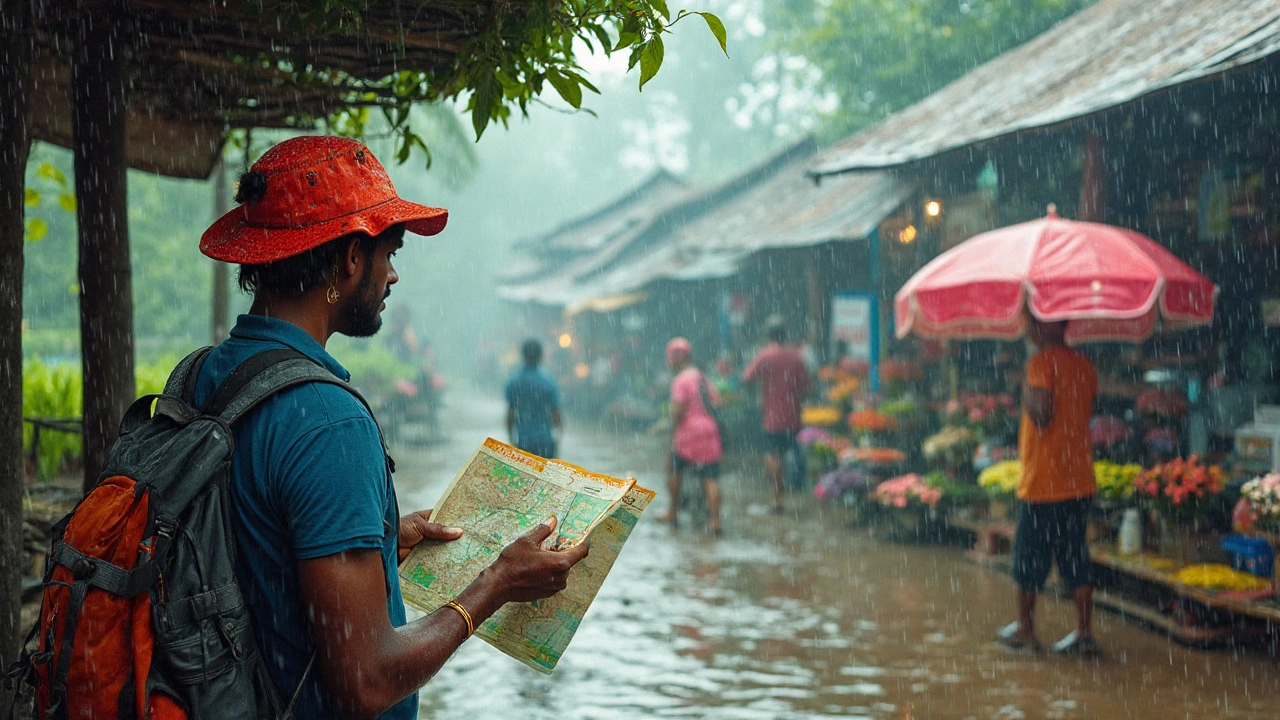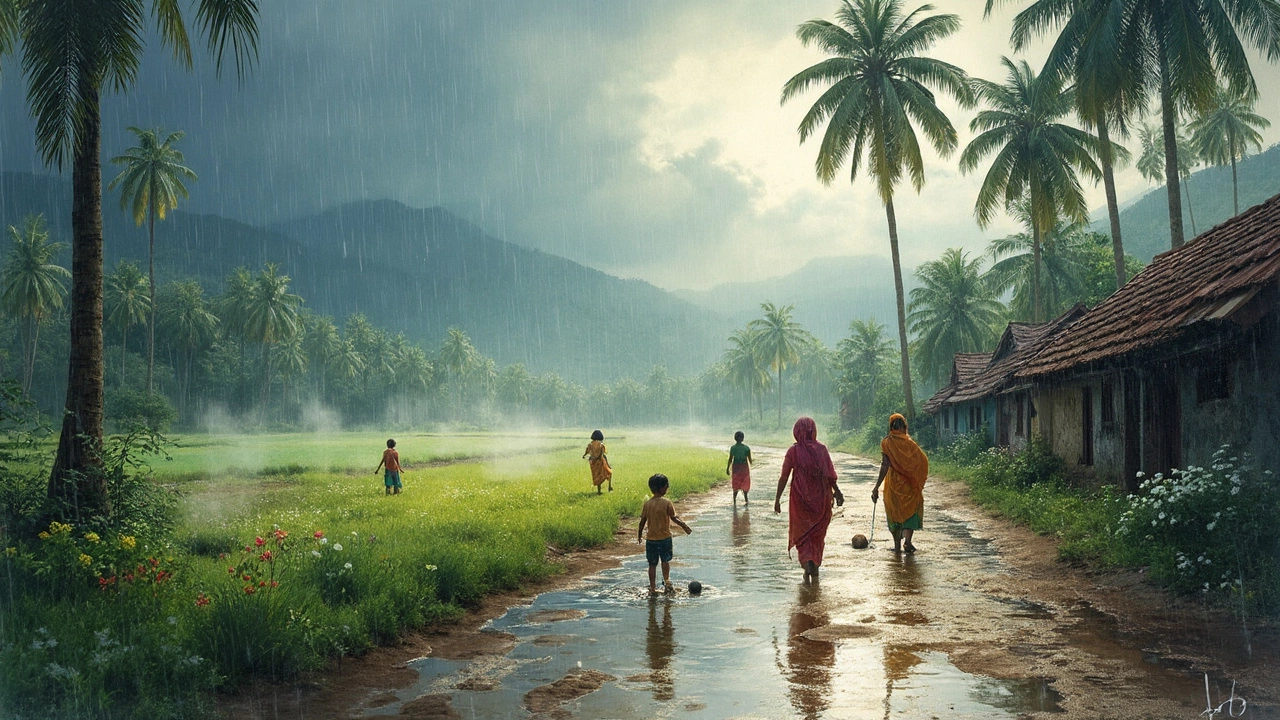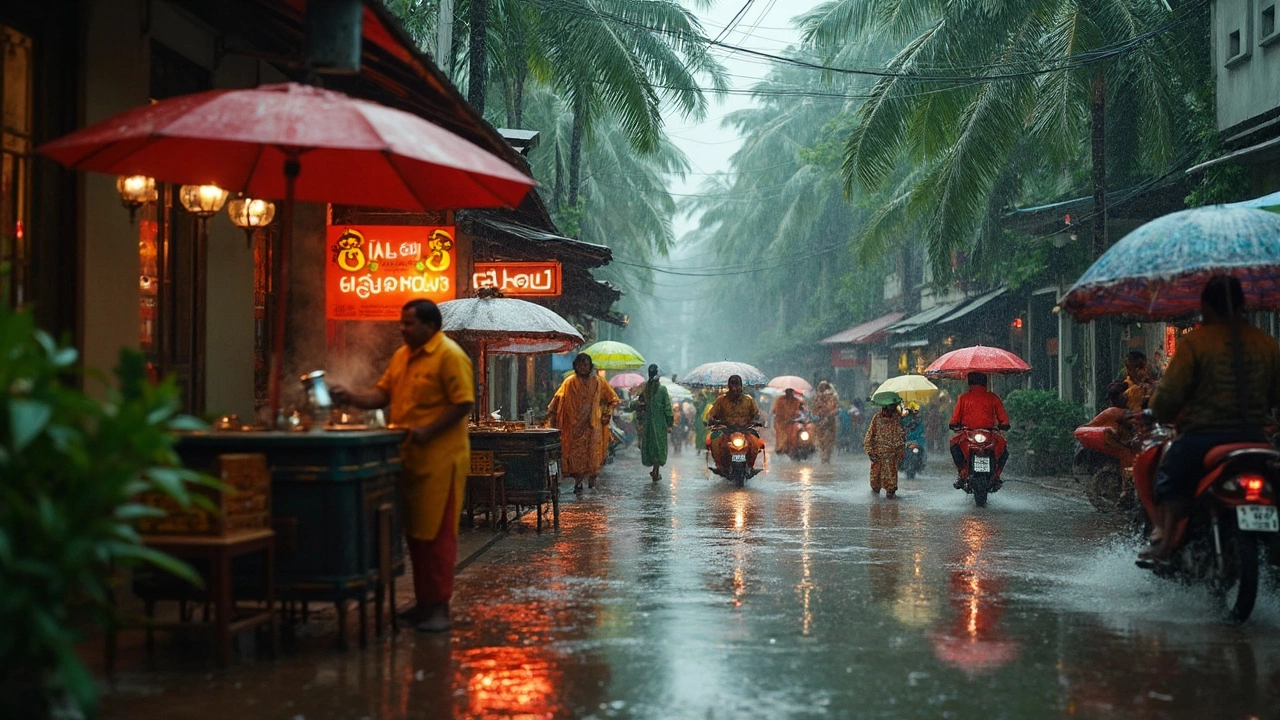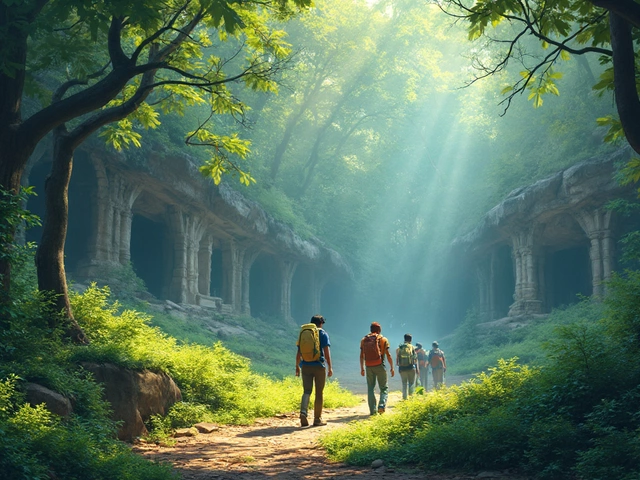Planning a trip to South India and worried about running straight into a giant wall of rain? You're definitely not alone. The rainy season—locals call it 'the monsoon'—completely transforms the region. One minute, you've got beaches and sunshine; the next, sudden showers and green landscapes everywhere.
Here’s something most guides skip: the monsoon isn’t just a bit of drizzle. In some spots, rain pours down so hard you can barely see three feet ahead. In others, it means just regular, quick showers that cool things off. Knowing where and when the rain hits gives you way more control over your travel plans—and helps you pack smart, too.
The timing of the rainy season makes or breaks a South India trip, whether you're hitting up Kerala’s backwaters, climbing the Nilgiri hills, or just trying to keep your feet dry in Chennai. Let’s zero in on the facts, so you know exactly what to expect and can dodge the common mistakes first-timers make while planning.
- How the Rainy Season Works in South India
- When Does the Monsoon Arrive?
- What South Indian Rain Really Feels Like
- Travel Tips for Monsoon Season
- Should You Visit in the Rain?
How the Rainy Season Works in South India
The rainy season here is totally tied to something called the southwest monsoon. Basically, warm, wet winds roll in from the Indian Ocean, slam into the Western Ghats (that's a long line of hills), and dump tons of water—especially on states like Kerala, Karnataka, Tamil Nadu, and parts of Andhra Pradesh.
This big weather pattern doesn’t just show up and leave in a hurry. The main rainy season usually starts in early June and can keep things wet all the way to September. But not every part of South India gets hit with the same force or at the same time. For example, Kerala usually catches the first drops, while places closer to the east coast, like Chennai, sometimes get most of their rain later, from October to December, thanks to the northeast monsoon.
Every year, the southwest monsoon brings around 70% of India’s total rainfall—South India definitely gets a big share of that. But there’s a twist: hill stations like Ooty or Munnar will see regular showers, but the air actually feels cooler and super fresh, while the coastlines might get wild storms and short power cuts.
Here's a look at how the rain can vary by state:
- Kerala: Heavy and regular rain, especially from June to September.
- Karnataka: Coastal areas get soaked, but inland cities like Bangalore see lighter, sometimes unpredictable showers.
- Tamil Nadu: Most of its rain arrives later in the year, not during the usual June-September window.
- Andhra Pradesh & Telangana: Rain is fairly spread out but isn’t as intense as on the west coast.
So, if you’re planning your adventure, keep in mind that the rainy season South India deals with is basically a double act—the southwest and northeast monsoons swap places and timing, depending where you go. Understanding these patterns makes trip planning, gear-packing, and avoiding travel headaches a whole lot easier.
When Does the Monsoon Arrive?
If you’re plotting out your calendar for that South India trip, this question is a big one. The rainy season, or monsoon, usually swings through South India in two waves. The main event is the Southwest Monsoon, which generally kicks off in early June and sticks around until late September. Think of it as Mother Nature’s reset button after the scorching summer.
Some areas start seeing gray skies and heavy showers even in late May, especially along the Kerala coastline. Kerala is where the monsoon first lands in India, sometimes as predictably as clockwork. According to the India Meteorological Department, "The onset of the Southwest Monsoon over Kerala normally occurs around June 1st each year."
The India Meteorological Department says: "The Southwest Monsoon hits Kerala around June 1st, gradually spreading eastwards and northwards."
After Kerala, the rain heads for coastal Karnataka, Tamil Nadu, and Andhra Pradesh. Places like Kochi or Mangalore will usually get the brunt first, while the cities farther east—like Chennai—see lighter showers until the Northeast Monsoon shows up (usually October to December).
Here’s how it usually rolls out:
- June: Rain arrives in Kerala, then moves inland.
- July–September: Monsoon covers most of South India, including the Western Ghats and interior regions.
- October–November: The Northeast Monsoon brings extra rain, especially to Tamil Nadu and parts of Andhra Pradesh.
It’s worth knowing that last-minute weather swings are common. Sometimes, the rain comes early or overstays its welcome. Check local forecasts before you travel, especially if your plans involve outdoor adventures, trekking, or coastal activities.
| Region | Monsoon Start | Peak Rainfall |
|---|---|---|
| Kerala | June 1 | June–July |
| Karnataka Coast | First week of June | June–August |
| Tamil Nadu | Late June (light) | October–November (heavy) |
| Andhra Pradesh | Mid-June | July–September |
So, mark your maps and keep some wiggle room in your plans—the rains make South India way more dramatic, but they sure don’t stick to a strict schedule every year.

What South Indian Rain Really Feels Like
The first thing that hits you about the rainy season in South India is how the rain just takes over the day. It can start out sunny, but out of nowhere, giant grey clouds slide in and let loose. When the monsoon starts—usually by early June in Kerala and a bit later as it moves east—the downpours are serious. Streets flood, traffic slows to a crawl, and sometimes, plans just have to change. Locals know to keep a sturdy umbrella handy and to never trust clear skies for too long.
But it’s not all chaos. The rain cools down the sweltering heat, makes the air feel fresher, and turns the countryside into a lush, bright green that almost doesn’t look real. Waterfalls roar to life, and rivers are suddenly full again. In cities like Kochi or Chennai, you might see kids splashing in puddles and street food vendors huddled under tarps serving snacks between showers.
Of course, there’s a flip side. Sudden heavy rain can cause power cuts, muddy roads, or even delay trains. On the coast, like along the beaches of Goa and Kerala, rough seas can mean lifeguard warnings or even beach closures. I remember my son Rylan refusing to leave the hotel in Alleppey one afternoon because he was convinced our tuk-tuk would float away. Not a totally crazy thought, considering how deep water can get on those side streets!
- Rain usually peaks in June and July in Kerala, while Tamil Nadu often gets most of its rain in October and November due to the northeast monsoon.
- Morning and night rains are common; it’s pretty common to wake up or go to bed to the sound of rain on the roof.
- Heavy afternoon downpours aren’t unusual, but they rarely last all day except during the peak weeks.
Here’s a quick look at just how much it can rain. During June, places like Munnar or Wayanad in Kerala easily see over 600 mm of rain in a single month. That’s more than London gets in half a year! Check this:
| City | Average Rainfall (June, mm) |
|---|---|
| Kochi | 750 |
| Chennai | 55 |
| Mysore | 90 |
One thing to watch for—mosquitoes love wet weather, so bring repellent. Also, travel might take longer, especially in the rural areas where roads can wash out. But if you’re willing to get a bit wet, you’ll see South India at its wildest and greenest.
Travel Tips for Monsoon Season
So you’re trying to make the most out of your rainy season South India trip? Here’s some real-world advice that’ll keep your holiday on track—even when the skies open up.
- Packing smart is non-negotiable. Raincoats are lighter than umbrellas and easier to stash in a backpack. Quick-dry clothes and waterproof shoes save you from that soggy-feet misery. My son Rylan hated wet socks—we always pack extras.
- Train travel beats road trips during heavy rains. Many roads can flood, especially in places like Kerala and coastal Karnataka. Indian Railways runs, rain or shine. Book tickets early though; locals use the same trick for a reason.
- Stay flexible with your itinerary. Attractions might close without notice if the rain’s too much, especially hill stations and wildlife sanctuaries. Have backup plans like museums, small cafes, or local markets.
- Covered transport is your best friend. Tuktuks (auto rickshaws) with plastic curtains do wonders in sudden showers, and cabs through apps like Ola or Uber mean you’re not left stranded in the downpour.
- Watch out for mosquitoes. More standing water means they come out in force. Bring good mosquito repellent, and look for accommodations that offer plug-in repellents or mosquito nets.
- Avoid swimming in rivers and waterfalls during peak monsoon. Currents can turn dangerous real fast. Official warnings aren’t always posted, so when in doubt, skip it.
- Stay updated on weather alerts. The Indian Meteorological Department (IMD) posts reliable forecasts. Download weather apps before your trip—some homestays use local WhatsApp groups to share updates too.
If you’re the stats type, check this out:
| State | Average Monsoon Rainfall (mm) | Most Affected Months |
|---|---|---|
| Kerala | ~3000 | June - September |
| Karnataka (Coast) | ~3800 | June - September |
| Tamil Nadu | ~950 | October - December |
Avoid areas with landslide warnings, especially if you’re headed to the Western Ghats. And don’t forget, monsoon means fewer crowds—hotels slash prices. You might get a nicer room for less, as long as you don’t mind the rain tapping on the roof at night.

Should You Visit in the Rain?
Here’s the straight truth: The rainy season South India can actually be a fun time to visit—if you know what you’re getting into. Sure, there’s a lot of water, but there are also fewer crowds, lusher scenery, and lower prices at hotels and resorts. You just have to decide what matters most for your trip.
Some places look their best during the monsoon. Kerala’s backwaters, for example, turn even greener, and you’ll see waterfalls everywhere. Hill stations like Munnar and Coorg get this fresh, misty vibe that’s totally different from the dry months. If you don’t mind getting wet, it’s kind of a magical switch-up from the usual tourist rush.
But here’s the flip side: all that rain sometimes leads to cancelled boat rides, road closures, or power cuts—especially in rural areas. Beaches aren’t the safest for swimming, and some nature trails get closed to prevent accidents. If you’re traveling with kids (like I sometimes do with my son Rylan), you’ll want to double-check activity schedules in advance.
If you’re looking for festivals, monsoon season has a few you’ll want to check out. The famous Onam festival in Kerala usually happens around August or September, and the celebrations are lively and full of traditional experiences. There’s also snake boat racing, which only happens during the rains and is a wild thing to watch.
So who has the best time during rainy season?
- Nature lovers—lush, green, misty landscapes everywhere
- Budget travelers—lower prices for accommodation and fewer tourists
- Festival fans—authentic local events like Onam and boat races
- People who hate crowds—big-ticket spots feel almost empty
Here’s one thing to watch: if you’re after beaches and lots of swimming, this isn’t the best choice. But if you want a laid-back trip, local food, and don’t mind carrying an umbrella, you might actually prefer South India in the rain.
Check out this quick look at pros and cons:
| Pros | Cons |
|---|---|
| Cheaper hotels, greener views, unique festivals, peace and quiet | Downpours, transport delays, some activities closed, not ideal for swimming |
Bottom line? Don’t write off the monsoon. With the right planning—and maybe some tough sandals—you could walk away with standout travel memories others miss entirely.



